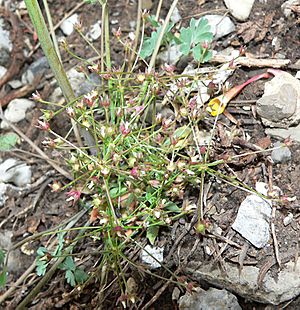Pygmyflower rockjasmine facts for kids
Quick facts for kids Pygmyflower rockjasmine |
|
|---|---|
 |
|
| Androsace septentrionalis subsp. subumbellata, Kyle Canyon, Spring Mountains, Nevada. | |
| Scientific classification | |
| Genus: |
Androsace
|
| Species: |
septentrionalis
|
| Subspecies | |
|
|
Androsace septentrionalis, also known as pygmyflower rockjasmine or Northern fairy candelabra, is a small plant. It belongs to the Primrose family, which is called Primulaceae. This plant grows in many parts of the world, including North America, Asia, and Europe.
It is an annual herbaceous plant. This means it lives for only one growing season and does not have a woody stem. The plant has a group of leaves that grow in a circle close to the ground, like a rosette. From this rosette, several stems grow upwards. Each stem holds a cluster of small white flowers that look like an umbrella, called an umbel.
Contents
What is Androsace septentrionalis?
Androsace septentrionalis is a tiny plant that grows from a basal rosette of simple leaves. These leaves have small teeth along their edges. The stems of the plant are smooth and do not have leaves on them. At the top of each stem, there is a group of flowers.
Features of the Flowers and Leaves
The flowers of this plant are very small. They have five parts that are split or cleft. The sepals, which are like small leaves that protect the flower bud, stay on the flower even after it blooms. The bracts are small, leaf-like structures found near the flowers. For this plant, these bracts are long and thin.
Where Does It Grow?
One type of this plant, called Androsace septentrionalis subsp. subumbellata, is considered threatened in Minnesota, a state in the United States. In Minnesota, this plant likes to grow in sandy, dry places. These areas are often found around old beach ridges and sand prairies. These habitats are sometimes called xeric habitats.
See also
 In Spanish: Androsace septentrionalis para niños
In Spanish: Androsace septentrionalis para niños

